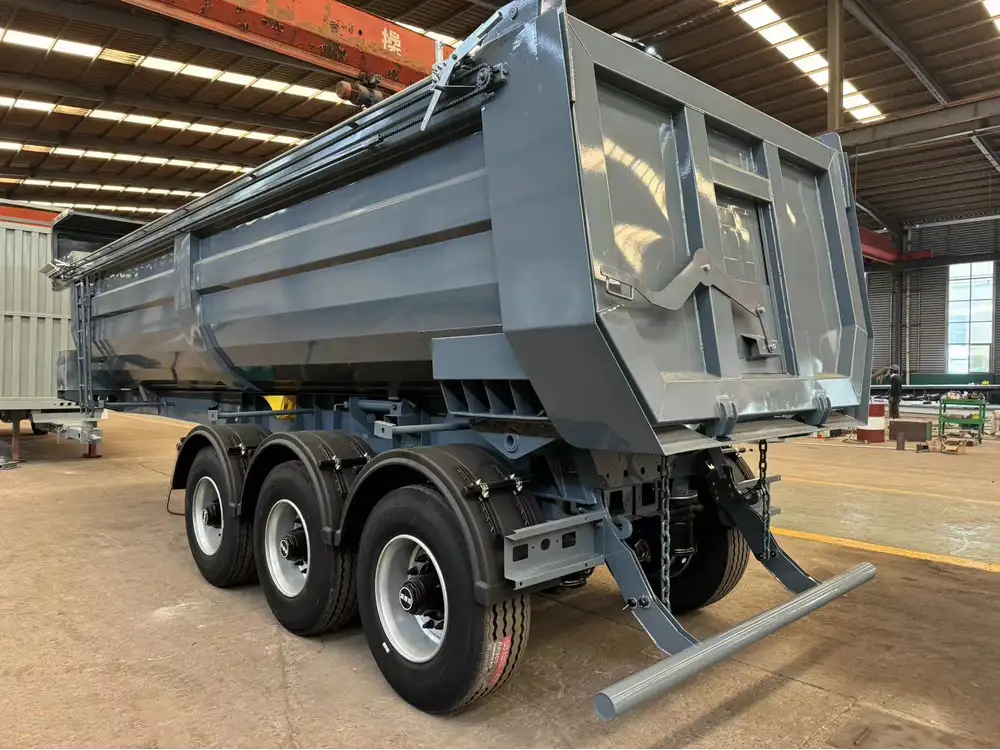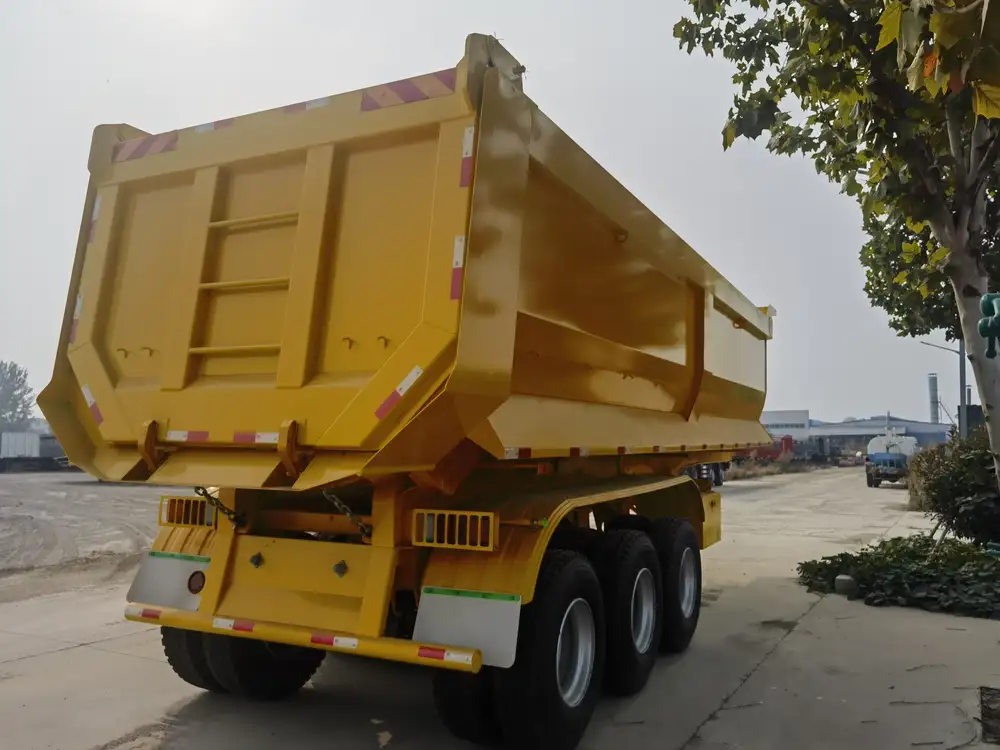Understanding Dump Trailer Mechanics
The performance of a dump trailer hinges on its tilt angle. The angle at which a dump trailer tilts is crucial for efficient unloading of materials, ranging from gravel to sand, dirt, or even heavy machinery. Getting the tilt right ensures that materials are discharged promptly, limiting the time spent on-site.
What is a Dump Trailer?
A dump trailer is a specialized piece of equipment designed to haul and unload materials. Typically coupled with a tow vehicle, it features a hydraulically operated bed that tilts to release its contents. Factors influencing its operation include:
- Weight Capacity: Different dump trailers can handle varying loads.
- Frame Material: Common materials include steel, aluminum, or composite.
- Hydraulic System: The power and efficiency of the system determine the tilt performance.

The Science Behind Tilt Angles
Understanding how angles affect unloading can provide insight into best practices for usage.
Anatomy of Tilt Angles
The effectiveness of a dump trailer during unloading is greatly influenced by its tilt angle. The general consensus among manufacturers and operators suggests:
- Optimal Tilt Angle: 45 degrees
- Minimal Angle for Individual Material Types:
| Material Type | Recommended Tilt Angle |
|---|---|
| Sand | 45 degrees |
| Gravel | 30-45 degrees |
| Dirt | 30 degrees |
| Heavy Machinery | 20 degrees |
Why Does Angle Matter?
Material Type: Different materials flow better at different angles. For instance, dry sand requires a more pronounced slope to promote free flow, while heavier materials like gravel can be discharged effectively at a shallower angle.
Safety Concerns: Incorrect tilt angles can lead to unstable loads and accidents. Ensuring the right angle minimizes risks on the job site.
Efficiency: A proper tilt angle reduces the need for multiple lifts, increasing unloading speed and productivity.

Hydraulic Mechanics of Tilt
The hydraulic systems in dump trailers allow for controlled tilting, offering precision in angle adjustment. Understanding these mechanics is essential:
- Hydraulic Cylinder Placement: Effective placement of hydraulic cylinders affects the angle achieved—a well-designed system provides smoother and safer operation.
- Pressure Sensitivity: The hydraulic system must withstand pressure fluctuations to ensure consistent performance, particularly when loaded with hefty materials.
Calculating the Right Angle for Your Needs
Determining the ideal tilt angle involves several key considerations, including weight distribution and material type.
Weight Distribution and Trailer Design
The design of the dump trailer plays an essential role in the optimal tilt angle. Factors include:
Load Center of Gravity: Loads that are evenly distributed will require less tilt to unload efficiently. Uneven weight can result in dangerous tipping.
Trailer Specifications: Manufactures provide tilt angle guidelines based on their specific designs. Always refer to your trailer’s manual for optimal performance parameters.
Load Capacity: understanding maximum and optimal loads ensures safety when tilting at required angles.

Material Properties
The material being unloaded will dictate the appropriate angle. Here’s a brief analysis:
- Sand: Requires a steeper angle for effective unloading due to its cohesiveness.
- Gravel: A tilt between 30-45 degrees is typically adequate.
- Dirt: A 30-degree angle suffices due to its less cohesive nature.
Practical Application of Tilt Angles
Step-by-Step Unloading Process
Preparation: Ensure the trailer is on flat ground. Position the load without overextending its weight limits.
Setting the Angle: Adjust the hydraulic system to reach the prescribed tilt angle.
Engaging the Tilt: Gradually engage the hydraulic tilt. Monitor the load closely to ensure safe, effective unloading.
Monitoring Unloading: Observe the flow of materials and adjust the angle if necessary to promote an even discharge.
Post-Unloading Checks: After unloading, check the hydraulic system and trailer for any signs of wear or damage.

Understanding Common Problems and Their Solutions
Despite best practices, issues can arise during the unloading process. Here’s how to troubleshoot effectively.
Common Problems
| Problem | Possible Causes | Solutions |
|---|---|---|
| Uneven Unloading | Poor load distribution | Ensure even weight distribution |
| Hydraulic Failure | Low pressure or leaks | Regular maintenance checks |
| Trailer Tipping | Excessive angle or weight | Monitor and adjust load capacity |
| Material Jamming | Incorrect angle or material type | Adjust angle according to the material |
Preventative Measures
Regular Maintenance: Regularly inspect hydraulic systems.
Proper Training: Ensure operators understand the nuances of trailer operation.
Load Management: Monitor load distribution consistently to avoid instability.

Industry Compliance and Safety Regulations
Understanding compliance with safety regulations cannot be understated. All dump trailers must adhere to transportation safety regulations mandated by governmental bodies. This includes:
Vehicle Weight Standards: Overloading can lead to severe penalties.
Safety Equipment: Ensure trailers are equipped with necessary safety mechanisms, including backup alarms and proper lighting.
Innovations in Dump Trailer Design
The manufacturing of dump trailers continues to evolve, driven by innovation. Emerging trends include:
Smart Technology: Integration of advanced hydraulic control systems offering automatic angle adjustments.
Weight Distribution Sensors: Real-time feedback mechanisms allowing operators to adjust loads dynamically.
Durability Improvements: Enhanced materials increasing trailer longevity and performance under pressure.
Conclusion: Mastering Dump Trailer Operation
Understanding the optimal tilt angle for dump trailers is a fundamental aspect of efficient operation. By grasping the nuances of weight distribution, material properties, and safety regulations, operators can significantly enhance their unloading efficiency while ensuring safety on the job site. With a commitment to regular maintenance and adherence to industry standards, dump trailer performance can be optimized, leading to greater productivity and operational success.
By integrating advanced technologies and following best practices, we pave the way for a future of seamless material management, ultimately fulfilling the diverse needs of our clientele in the semi-trailer manufacturing industry.
For further insights on trailer operations or to explore our extensive lineup of trailers, feel free to reach out. We are here to help you optimize your transportation solutions continuously!



